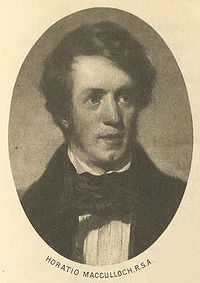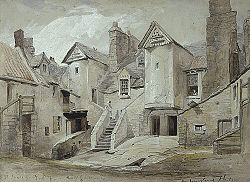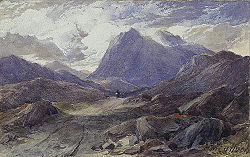
Horatio McCulloch
Encyclopedia

Glasgow
Glasgow is the largest city in Scotland and third most populous in the United Kingdom. The city is situated on the River Clyde in the country's west central lowlands...
, Scotland
Scotland
Scotland is a country that is part of the United Kingdom. Occupying the northern third of the island of Great Britain, it shares a border with England to the south and is bounded by the North Sea to the east, the Atlantic Ocean to the north and west, and the North Channel and Irish Sea to the...
– 1867 in Edinburgh
Edinburgh
Edinburgh is the capital city of Scotland, the second largest city in Scotland, and the eighth most populous in the United Kingdom. The City of Edinburgh Council governs one of Scotland's 32 local government council areas. The council area includes urban Edinburgh and a rural area...
, Scotland
Scotland
Scotland is a country that is part of the United Kingdom. Occupying the northern third of the island of Great Britain, it shares a border with England to the south and is bounded by the North Sea to the east, the Atlantic Ocean to the north and west, and the North Channel and Irish Sea to the...
) was a Scottish landscape painter.
Life
Horatio McCulloch was trained in the studio of the GlasgowGlasgow
Glasgow is the largest city in Scotland and third most populous in the United Kingdom. The city is situated on the River Clyde in the country's west central lowlands...
landscape painter John Knox (1778–1845) for about one year and at first earned his living as a decorative painter. He was then engaged at Cumnock
Cumnock
Cumnock is a town in East Ayrshire, Scotland. The town sits at the confluence of the Glaisnock Water and the Lugar Water...
, painting the ornamental lids of snuffboxes, and afterwards employed in Edinburgh
Edinburgh
Edinburgh is the capital city of Scotland, the second largest city in Scotland, and the eighth most populous in the United Kingdom. The City of Edinburgh Council governs one of Scotland's 32 local government council areas. The council area includes urban Edinburgh and a rural area...
by Lizars, the engraver, to color the illustrations in Selby's British Birds and similar works.
After he moved to Edinburgh
Edinburgh
Edinburgh is the capital city of Scotland, the second largest city in Scotland, and the eighth most populous in the United Kingdom. The City of Edinburgh Council governs one of Scotland's 32 local government council areas. The council area includes urban Edinburgh and a rural area...
in 1825, he began painting in the tradition of Alexander Nasmyth
Alexander Nasmyth
Alexander Nasmyth was a Scottish portrait and landscape painter, often called the "father of Scottish landscape painting".-Biography:...
. Working unweariedly from nature, he was greatly influenced in his early practice by the watercolours of H. V. Williams. He returned to Glasgow
Glasgow
Glasgow is the largest city in Scotland and third most populous in the United Kingdom. The city is situated on the River Clyde in the country's west central lowlands...
in 1827,and was employed on several large pictures for the decoration of a public hail in St. George's Place, and he did a little as a theatrical scene-painter. About this time by the writings of Sir Walter Scott
Walter Scott
Sir Walter Scott, 1st Baronet was a Scottish historical novelist, playwright, and poet, popular throughout much of the world during his time....
and the expressive landscape works of John Thompson, friend of Scott's and minister at Duddingston
Duddingston
Duddingston is a former village in the east of Edinburgh, Scotland, next to Holyrood Park.-Origins and etymology:The estate wherein Duddingston Village now lies was first recorded in lands granted to the Abbot of Kelso Abbey by David I of Scotland between 1136–47, and is described as stretching...
Kirk
Kirk
Kirk can mean "church" in general or the Church of Scotland in particular. Many place names and personal names are also derived from it.-Basic meaning and etymology:...
, Edinburgh
Edinburgh
Edinburgh is the capital city of Scotland, the second largest city in Scotland, and the eighth most populous in the United Kingdom. The City of Edinburgh Council governs one of Scotland's 32 local government council areas. The council area includes urban Edinburgh and a rural area...
. Gradually MacCulloch asserted his individuality, and formed his own style on a close study of nature; his works form an interesting link between the old world of Scottish landscape and the new.

Glasgow
Glasgow is the largest city in Scotland and third most populous in the United Kingdom. The city is situated on the River Clyde in the country's west central lowlands...
Dilettanti Society and with the Royal Scottish Academy
Royal Scottish Academy
The Royal Scottish Academy is a Scottish organisation that promotes contemporary Scottish art. Founded in 1826, as the Royal Institution for the Encouragement of the Fine Arts, the RSA maintains a unique position in Scotland as an independently funded institution led by eminent artists and...
had begun to attract buyers, notably the newly instituted Association for the Promotion of the Fine Arts in Scotland. A commission from Lord Provost James Lumsden helped established the artist's reputation within Scotland. Commissions from book and print publishers allowed him to concentrate on easel painting.
On his election as full Academician of the Scottish Academy in 1838, McCulloch settled in Edinburgh
Edinburgh
Edinburgh is the capital city of Scotland, the second largest city in Scotland, and the eighth most populous in the United Kingdom. The City of Edinburgh Council governs one of Scotland's 32 local government council areas. The council area includes urban Edinburgh and a rural area...
and soon became a prominent figure in the artistic life of the capital and a prolific contributor to the Royal Scottish Academy
Royal Scottish Academy
The Royal Scottish Academy is a Scottish organisation that promotes contemporary Scottish art. Founded in 1826, as the Royal Institution for the Encouragement of the Fine Arts, the RSA maintains a unique position in Scotland as an independently funded institution led by eminent artists and...
exhibitions. At the same time contact with Glasgow
Glasgow
Glasgow is the largest city in Scotland and third most populous in the United Kingdom. The city is situated on the River Clyde in the country's west central lowlands...
was maintained: McCulloch’s favorite sketching grounds were in the west, he exhibited regularly in the city and his most loyal patrons were wealthy Glasgow
Glasgow
Glasgow is the largest city in Scotland and third most populous in the United Kingdom. The city is situated on the River Clyde in the country's west central lowlands...
industrialists such as David Hutcheson (1799–1881), the steamship owner. He seldom exhibited outside Scotland and only once at the Royal Academy
Royal Academy
The Royal Academy of Arts is an art institution based in Burlington House on Piccadilly, London. The Royal Academy of Arts has a unique position in being an independent, privately funded institution led by eminent artists and architects whose purpose is to promote the creation, enjoyment and...
, London
London
London is the capital city of :England and the :United Kingdom, the largest metropolitan area in the United Kingdom, and the largest urban zone in the European Union by most measures. Located on the River Thames, London has been a major settlement for two millennia, its history going back to its...
(1843), but he kept in touch with London artist–friends, John Phillip
John Phillip
John Phillip was a Victorian era painter best known for his portrayals of Spanish life. He was nicknamed "Spanish Phillip"....
, David Roberts
David Roberts (painter)
David Roberts RA was a Scottish painter. He is especially known for a prolific series of detailed lithograph prints of Egypt and the Near East that he produced during the 1840s from sketches he made during long tours of the region . These, and his large oil paintings of similar subjects, made him...
and John Wilson (1774–1855), through correspondence and visits. His own art collection was evidence of his admiration for 17th-century Dutch painters, for J. M. W. Turner
J. M. W. Turner
Joseph Mallord William Turner RA was an English Romantic landscape painter, watercolourist and printmaker. Turner was considered a controversial figure in his day, but is now regarded as the artist who elevated landscape painting to an eminence rivalling history painting...
and Richard Wilson
Richard Wilson (painter)
Richard Wilson was a Welsh landscape painter, and one of the founder members of the Royal Academy in 1768. Wilson has been described as '...the most distinguished painter Wales has ever produced and the first to appreciate the aesthetic possibilities of his country.' He is considered to be the...
and for contemporaries such as Clarkson Stanfield.
McCulloch died on June 24 in 1867. He is buried at Warriston Cemetery
Warriston Cemetery
Warriston Cemetery lies in Warriston, one of the northern suburbs of Edinburgh, Scotland. It was built by the then newly formed Edinburgh Cemetery Company, and occupies around of land on a slightly sloping site...
in Edinburgh
Edinburgh
Edinburgh is the capital city of Scotland, the second largest city in Scotland, and the eighth most populous in the United Kingdom. The City of Edinburgh Council governs one of Scotland's 32 local government council areas. The council area includes urban Edinburgh and a rural area...
.

Works
During his lifetime Horatio McCulloch became the best-known and most successful landscape painter in Scotland. His constant aim was to paint the silence of the Highland wilderness where the wild deer roam with the kind of poetic truthfulness he admired in Wordsworth. The accomplished watercolours and broadly painted oil sketches that he produced throughout his career attracted little notice at the time and have remained comparatively unknown.His early works include paintings of Cadzow Forest near Hamilton
Hamilton, South Lanarkshire
Hamilton is a town in South Lanarkshire, in the west-central Lowlands of Scotland. It serves as the main administrative centre of the South Lanarkshire council area. It is the fifth-biggest town in Scotland after Paisley, East Kilbride, Livingston and Cumbernauld...
and grand views of the Clyde
River Clyde
The River Clyde is a major river in Scotland. It is the ninth longest river in the United Kingdom, and the third longest in Scotland. Flowing through the major city of Glasgow, it was an important river for shipbuilding and trade in the British Empire....
. He undertook regular summer sketching tours of the West Highlands
Scottish Highlands
The Highlands is an historic region of Scotland. The area is sometimes referred to as the "Scottish Highlands". It was culturally distinguishable from the Lowlands from the later Middle Ages into the modern period, when Lowland Scots replaced Scottish Gaelic throughout most of the Lowlands...
, completing the sketches as paintings as back in his studio. These paintings celebrate the romantic scenery of the Scottish Highlands
Scottish Highlands
The Highlands is an historic region of Scotland. The area is sometimes referred to as the "Scottish Highlands". It was culturally distinguishable from the Lowlands from the later Middle Ages into the modern period, when Lowland Scots replaced Scottish Gaelic throughout most of the Lowlands...
and evoke a magnificent sense of scale, emphasizing the dramatic grandeur. Horatio McCulloch had by his death in 1867 created the essential iconography of the Highlands.
From historical point of view, as the Scottish Lowlands became more urbanised, the distinctiveness of Scotland came to be represented through the Highlands. McCulloch's work was part of a process of distancing the relationship of people to land in the Highlands. In the Victorian period the Highlands to be defined as a wilderness instead of a populated space and many communities were cleared from the land in favor of large sheep farms and sporting interests. In essence, this romantic view of Scottish scenery was brought to a climax by Horatio McCulloch.
Several works by McCulloch were engraved by William Miller and William Forrest, and volume of photographs from his landscapes, with an excellent biographical notice of the artist by Alexander Fraser, R.S.A.
Royal Scottish Academy
The Royal Scottish Academy is a Scottish organisation that promotes contemporary Scottish art. Founded in 1826, as the Royal Institution for the Encouragement of the Fine Arts, the RSA maintains a unique position in Scotland as an independently funded institution led by eminent artists and...
, was published in Edinburgh
Edinburgh
Edinburgh is the capital city of Scotland, the second largest city in Scotland, and the eighth most populous in the United Kingdom. The City of Edinburgh Council governs one of Scotland's 32 local government council areas. The council area includes urban Edinburgh and a rural area...
in 1872.

- Inverlochy Castle (1857)
- Landscape Evening (c1960)
- Glencoe, Argyllshire (1864)
- Loch Katrine (1866)

